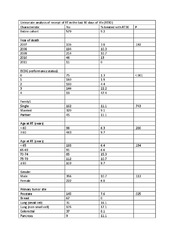Palliative RT Score
Permanent lenke
https://hdl.handle.net/10037/6387Åpne
tabell 1 (PDF)
figur 2 (PDF)
Tabell 3 (PDF)
tabell 2 (PDF)
Artikkelen (PDF)
Dato
2013-06-02Type
Master thesisMastergradsoppgave
Forfatter
Angelo, KentSammendrag
Purpose
To develop predictive models that allow for reduced overutilization of palliative radiotherapy (PRT) during the final 30 days of life in patients with incurable cancer.
Patients and Methods
Uni- and multivariate analyses of factors predicting PRT during the final 30 days of life for all PRT courses administered at a dedicated PRT facility between 20.06.07 and 31.12.2009. Development of a predictive model by recursive partitioning analysis (RPA) and independent validation of its performance in patients treated during 2010 and 2011.
Results
We analyzed 579 PRT courses. Median survival was 6.3 months. In 53 cases (9%) PRT was administered during the final 30 days of life. RPA resulted in a model consisting of 6 parameters (low hemoglobin, opioid analgesic use, ECOG performance status (PS) 3-4, known progressive disease outside PRT volume, steroid use, lung or bladder cancer), which correctly identified 75% of PRT courses administered during the final 30 days of life. Maximum survival of patients fulfilling all criteria was 69 days. Death within 40 days occurred in 83%. In the independent validation data set these figures were 74% (30 days), 84% (40 days) and 100% (92 days).
Conclusion
Assigning the right patient to the right palliative approach is challenging. We suggest that patients with lung or bladder cancer and the other adverse features mentioned above are at high risk of dying shortly after initiation of PRT. Our model supports decision making (best supportive care versus PRT) and is the first decision aid specifically addressing PRT near end of life.
Forlag
Universitetet i TromsøUniversity of Tromsø
Metadata
Vis full innførselSamlinger
- Mastergradsoppgaver Helsefak [1338]
Copyright 2013 The Author(s)
Følgende lisensfil er knyttet til denne innførselen:


 English
English norsk
norsk
